This is an insider’s tips for the best Machu Picchu pictures, compiled after many visits. There are many different angles of this fabulous city and this is an excellent photography guide to getting that perfect, different, or enigmatic glimpse of these famous ruins! Read on for all our tips and tricks on photographing Machu Picchu and how to take the best photos of Machu Picchu on your trip. Plus, get the latest on the ever-changing regulations on Machu Picchu entry.
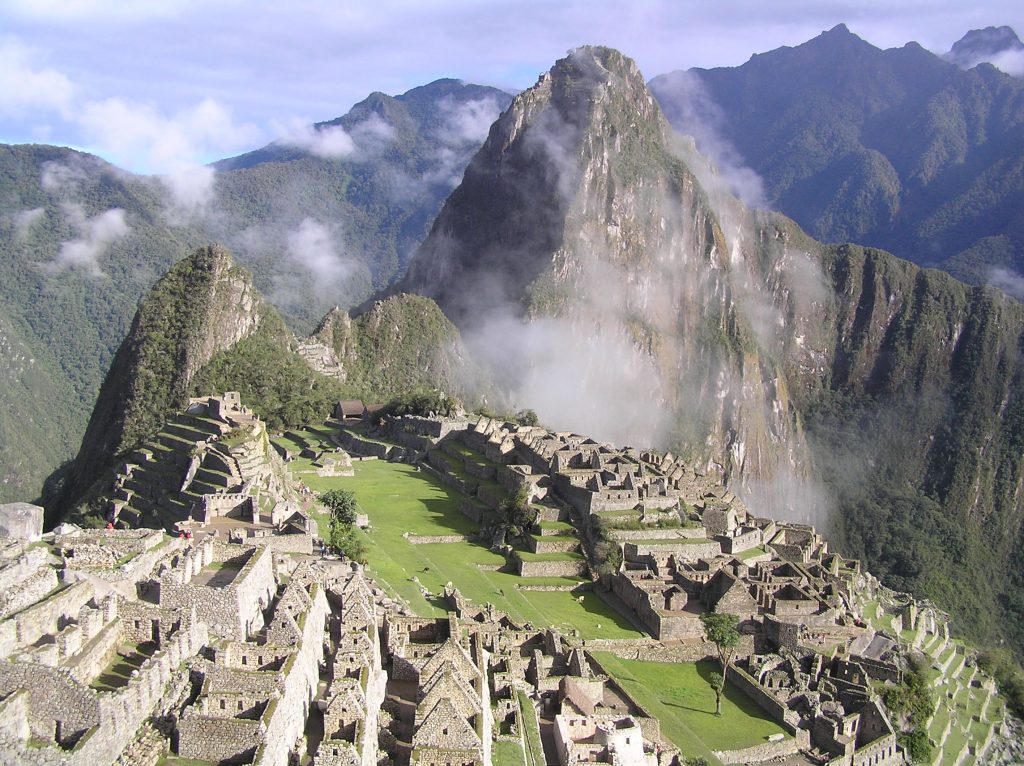
It’s fair to say that Machu Picchu is among the most photographed places on earth, but so many photos are similar. Everyone gets the “classic” Machu Picchu pics. This guide doesn’t assume to be a ‘how to photograph’ Machu Picchu guide but an overall view of the logistics and angles for a spectacular and unique shot! We do not profess to be anything more than amateur photographers but do provide tips that will help you get the best photos of Machu Picchu.
Alternatively you might consider joining a Machu Picchu photography tour to get some unique ideas from an expert guide.
This post may contain affiliate links, from which we would earn a small commission, at no extra cost to you. More info in my disclaimer.
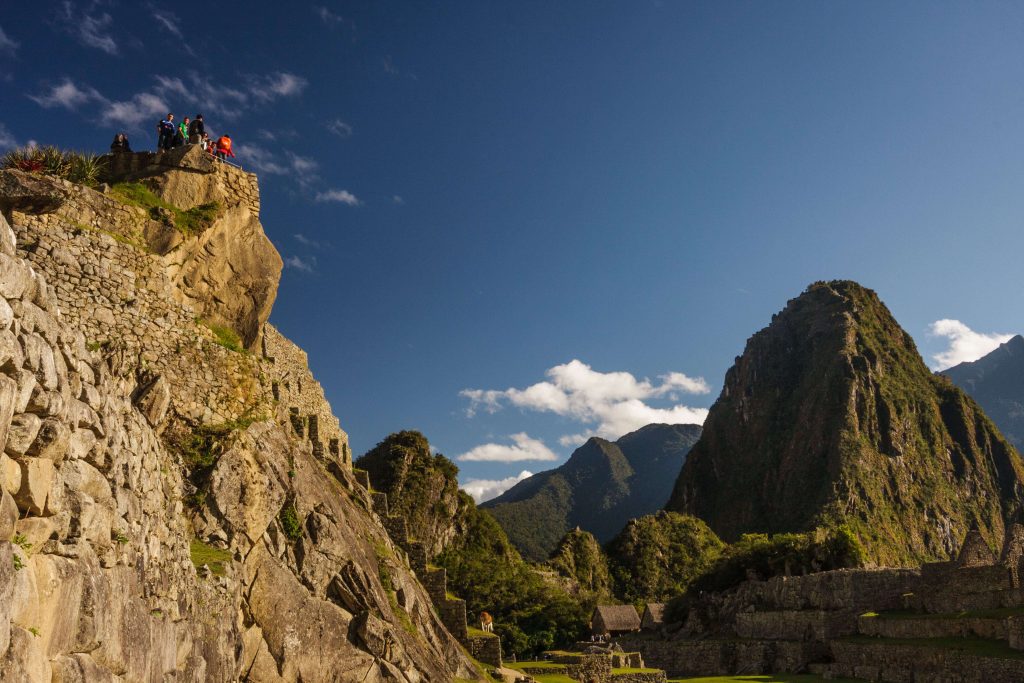
Logistics For The Best Machu Picchu Pictures
Machu Picchu Regulations
You need to get a grip on Machu Picchu’s ever-changing regulations if you are to get the best Machu Picchu pictures you can. This has become a very lengthy section of this post (and a continually changing one).
Machu Picchu Weather
So, you are wondering, “What is the best time of year to visit Machu Picchu?” It is possible to get great pictures of Machu Picchu despite the weather!
Machu Picchu is located in the high jungle. “The eyebrow of the jungle” in Spanish and is generally wet and moist all year round. Even in Cusco’s dry/high season (June – August), you will get rainy days. On these days there is a lot of cloud, mist and it is extremely atmospheric – perfect for moody and artistic photos!
However, if you want to be sure of a rain-free day, consider planning two days at the site. Some of the most beautiful and best Machu Picchu photos we have taken was during a December visit, when it’s slightly less busy. Weigh up the pros & cons of adding an extra day to your itinerary in order to get the ‘perfect’ Machu Picchu pictures.
Sunrise Over Machu Picchu
Plenty of glossy brochures talk about ‘being at Machu Picchu at sunrise’. In our experience, sunrise at Machu Picchu is overrated as the site seems shrouded in mist in the very early morning and the sunrise comes up over one of the neighboring mountains. That said, on a clear, slightly misty morning it is gorgeous! Knowing the best time of day is key for photographing Machu Picchu.
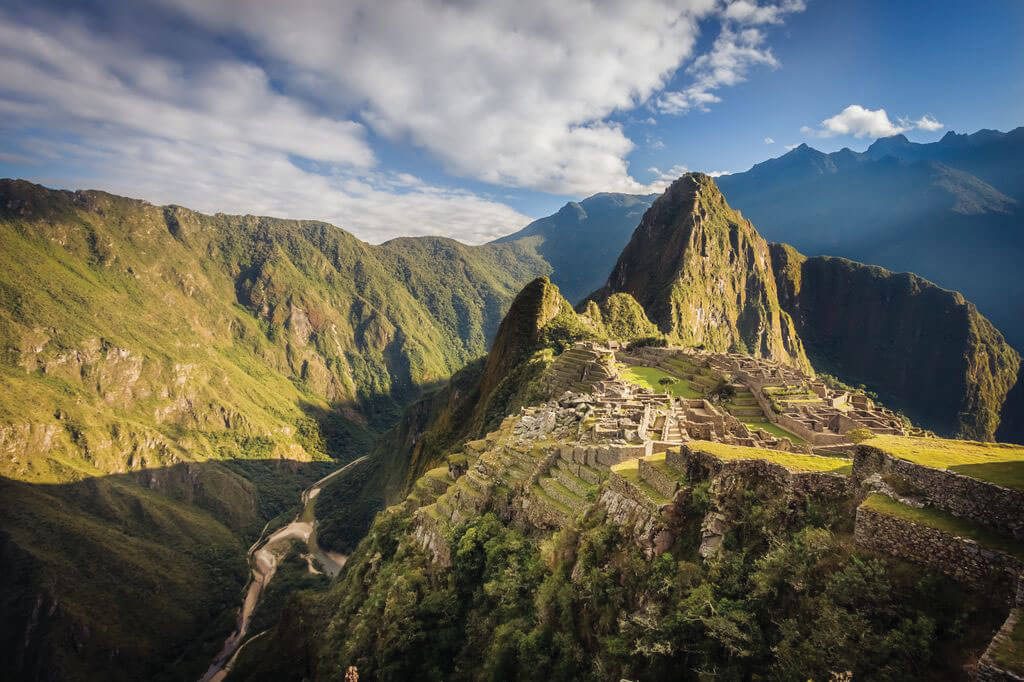
Time Of Day
Not with-standing to the point above about sunrise over Machu Picchu, go early and you will be rewarded by fewer people and some stunning light clouds floating over the site. Machu Picchu’s gates open at 6 am and by 9 am there are a lot of crowds. To be among the first in the gates at 6 am be prepared to be in the bus line at around 4 am.
Generally, our favorite time for people free pictures of Machu Picchu has been about 3 pm. By then most people have gone home and the site is blessed with a gentle light. Keep in mind, this would require an Afternoon Permit. For more information, see our information on Machu Picchu regulations below.
Be Prepared To Wait
When giving our Machu Picchu photography tips, we have to say, “Patience is a virtue!” If you wait long enough, the eople come and go and eventually, you can get a photo without the crowds if that is what you are looking for. Keeping in mind that if you have allowed two days to shoot your photos it should be easier to be patient. Getting truly great pictures of Machu Picchu can be a treasured souvenir from Peru.
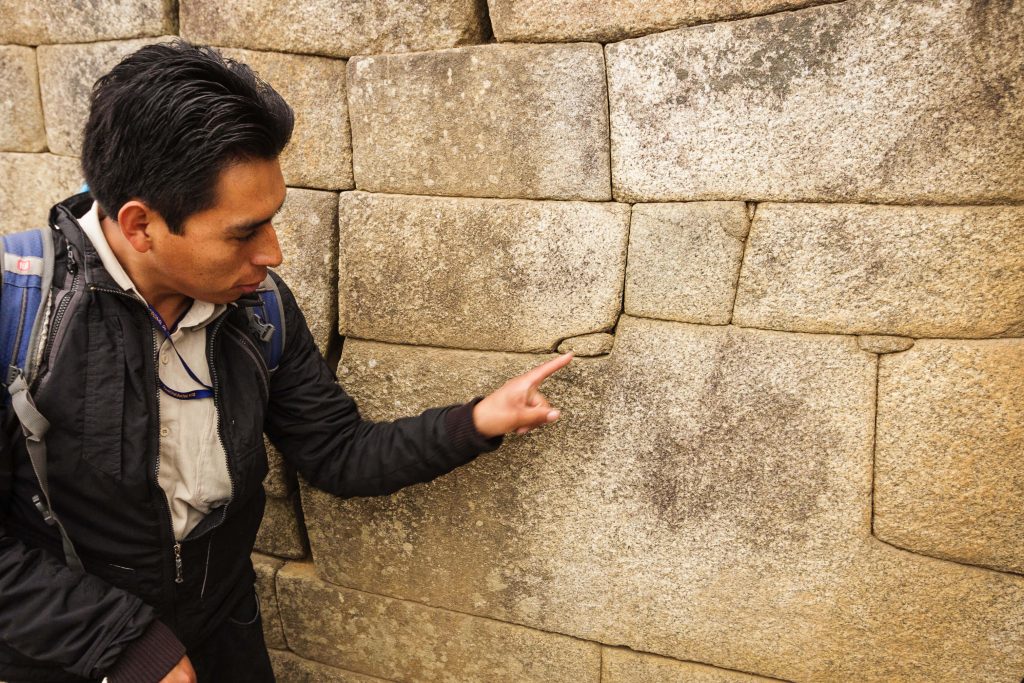
Get Up Close
There is much beauty in the details! When photographing Machu Picchu look for the stones, close-ups for different angles. Everyone wants the wide-angle shots of the ruins, and no doubt those are beautiful. However, don’t underestimate getting some great up-close Machu Picchu pictures too. Alternatively you might consider joining a Machu Picchu photography tour to get some unique ideas from an expert guide.
Types of Machu Picchu Photography
Is Machu Picchu worth visiting, from a photography point of view? Absolutely! And to get the very best images, a little creativity can go a long way. Here are some ideas to make your pictures stand out.
Wide-angle shots
These are the most popular type of shot, and really give your pictures a sense of scale. Try to capture as many images of each view as you can – you can always delete any unwanted ones. Changing the camera angle even slightly can result in a completely different image.
Close-up shots
Focus on the details for unique Machu Picchu photos. Stonework, sets of steps, and individual temples all work well. Keep your eyes peeled for anything that will make an interesting image.
Framed shots
Use what’s around to frame your picture. This can really add interest, elevating the average shot to something truly special. Branches, windows, and doorways can all work really well. Or even try using someone’s hands!
People
When you look through other people’s pictures after they’ve been away, the chances are you tend to pay more attention to those with human beings in them. So don’t forget to capture some! They also act as a long-lasting memento of your trip.
Don’t forget to grab a group photo, plus any with new friends you’ve made along the way. It will help you to remember the experience, later in life. With a bucket list trip like this, you really do want the memories to go on for as long as possible.
Animals
Whether it’s a selfie with the animals, or a landscape shot with them in the foreground, the llamas you’ll see wandering around the Lost City of the Incas can also make your photos more interesting.
When to Take the Best Machu Picchu Photos
Mid to Late Afternoon
Obviously, you should get to Machu Picchu as early as possible. But you might not have much control over that, depending on what your group is doing. By late afternoon, though, the crowds should have thinned, making this a better time for those prepared to wait. From about 3 pm onwards is perfect.
Wet or Dry Season
For fewer people, think about visiting Machu Picchu in the wet season. The downside is that it’s rainy! Which might not make for the best pictures.
During the dry season the weather is more reliable. But the site is also much busier then, as this is the most popular time to travel.
What to Pack for the Best Pictures of Machu Picchu
If you want the best photos of Machu Picchu you can possibly get, then you’ll need to plan accordingly. For good, original photos of the Machu Picchu ruins, a proper camera is perfect, rather than your iPhone.
Camera
Compact, point-and-shoot cameras or GoPros are ideal for Machu Picchu, where packing space is at a premium.
Compact Cameras
A compact, point-and-shoot camera is ideal for Machu Picchu. While the best photos might come from a big, bulky camera, the reality is that what you can take is very limited.
Good brands include Canon, Nikon, and Sony. Options range from pocket-sized cameras to larger models suitable for vlogging. Think about what you really have room for, before making your choice!
GoPros
A GoPro is an alternative to consider. These action cameras are waterproof, so they can cope with whatever the weather brings. For Machu Picchu, and the best pictures and footage you can get, they are ideal.
GoPros tend to capture 20MP plus photos, and 5K plus Ultra HD video. They’re also typically capable of live streaming, can act as a webcam, and offer effective image stabilization. Exact specifications vary, according to the model you pick.
Batteries
Camera Batteries
Don’t forget to pack some spare camera batteries. It probably goes without saying, but make sure they’re the right ones for your make and model!
Power Bank
A portable power bank can be a godsend when you’ll be getting off-grid, anywhere in the world. Again, check it’s compatible with your device before buying.
SD card
Packing a spare SD card is a very good idea, and they’re very compact and lightweight indeed. It could be pretty frustrating if you’re getting some great pictures, only to run out of storage space!
Waterproof Cover
It’s often misty at Machu Picchu, and you can often expect drizzle, rain, or even storms. Especially if you decide to visit during the wet season.
Waterproof Camera Bag
The first option here is to take a waterproof camera bag. It will protect your equipment from knocks as well as rain. The only downside is that this will add extra bulk, though some lightweight sleeves for smartphones and cameras are available.
Waterproof Daypack Cover
A rainproof cover for your backpack is an alternative. Covering your whole daypack will protect all of the contents. The downside is that your camera will have more chance of getting wet between getting it out, using it, and putting it away again.
But perhaps you could use your backpack cover as some sort of improvised sleeve sometimes, wrapping it up in the cover until you want to point and shoot. Just take care not to drop it if you do this!
Rain Poncho
A third option is to take along a lightweight rain poncho. This does double duty, as it covers you as well as the camera. Again, you could use this to wrap the camera up in, too, but again be careful not to let it slip from your grasp.
What Not to Bring to Machu Picchu
Just as important as what to pack for Machu Picchu is what not to waste your time, money, and valuable luggage space on! Avoid the following at all costs.
Extra Equipment
Think twice – and then several times more – before packing unnecessary extra lenses, filters, and particularly camera bodies. The latter are very bulky, and can be heavy, too.
Professional photographers tend to pay a fee when entering the site. So anything that makes you seem like you fit the bill could also hit your wallet where it hurts!
Drones
As you might imagine, the use of drones is prohibited at this fragile, historic site. A drone would also have the potential to ruin other travelers’ pictures. This won’t make you popular with the group.
Tripods
Tripods are not permitted at Machu Picchu. In any case, you won’t need them. They’re also something else to carry – and that you’re very unlikely to have space for.
Props
Just forget it. Props aren’t required, and nor will you have the capacity for carrying them.
Is Machu Picchu Worth it for Photographers?
There are two main reasons to take pictures at Machu Picchu. Firstly, they’ll act as a lasting memento of your trip. Especially in the distant future, when the memories fade over time. So, yes, of course you want to capture this bucket list experience on camera!
The other reason for photographing Machu Picchu is for creative purposes. There’s a lot you can do, including close-ups and framing, as well as the usual shots. So do try using some artistic license for the best results.
If you get great shots, they could even end up as something like a coffee table album, or feature wall in your home. Either would be a pretty cool reminder of your Peru adventure!

Where Should I Stay For the Best Machu Picchu Photos?
If you had the budget you can also choose to stay at Belmond Sanctuary Lodge which is the only hotel located at Machu Picchu. Though expensive, it gives you the most optimal access to visiting and taking the best photos of Machu Picchu. Check here for the most recent prices to stay at Belmond Sanctuary Lodge.
Alternatively there are many options -of all budgets in Macchu Picchu village (better known as Aguas Calientes.) We provide a list of our favourites if you click on the Hotel tab at our information packed Aguas Calientes information.
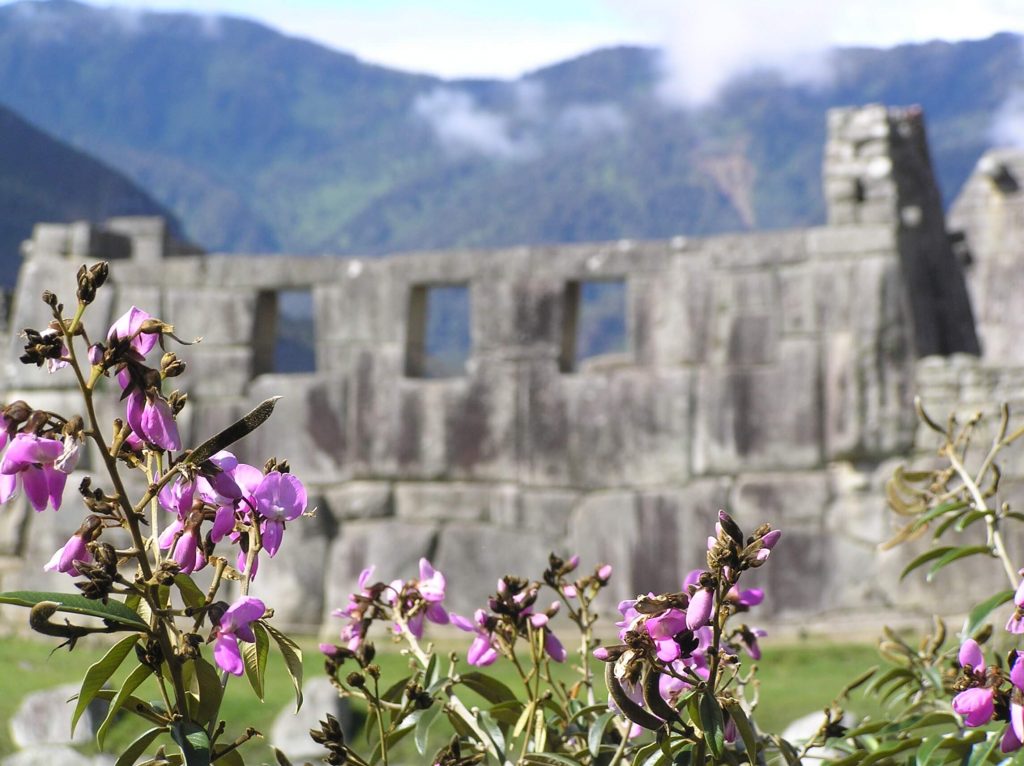
Different Angles For The Best Machu Picchu Pictures
Based on our many visits to Machu Picchu with kids and without kids these are some different angles you can think about when photographing Machu Picchu! Whether you have photography on your mind or are simply there for an adventure, try these different angles for capturing the best photos of Machu Picchu.
The Classic Shot
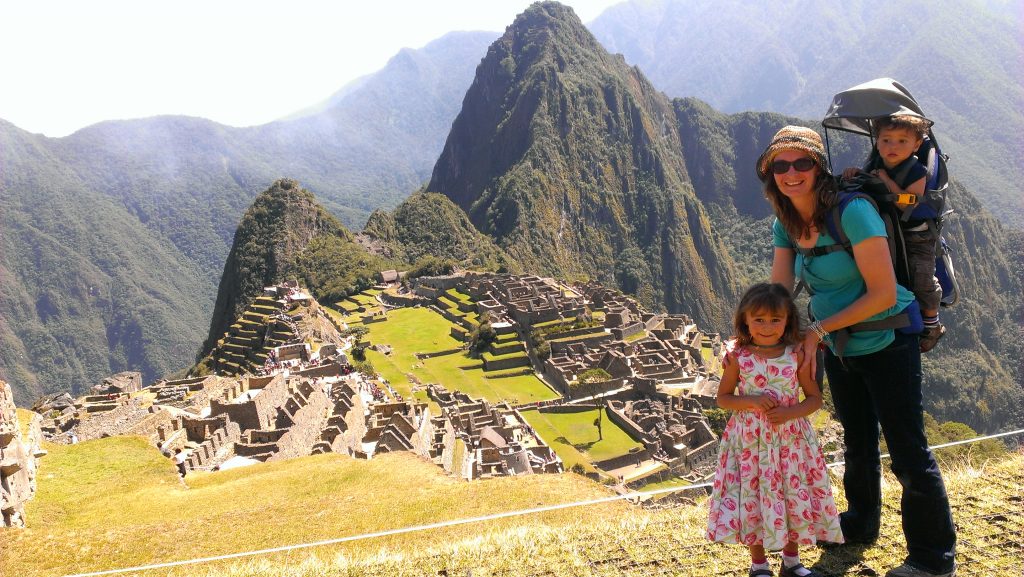
It is said that travelers in Incan times had to undergo cleansing rituals at the Caretakers Cottage before being allowed into the Sacred City. Things aren’t so stringent these days, however. This is the classic Machu Picchu photograph taken by thousands. Get here early in the day as it only gets busier as the day goes on. Not only will that make your potential wait for this classic Machu Picchu picture shorter, but you will have fewer people at the ruins in your photos as well.
Inti Punku (The Sun Gate)
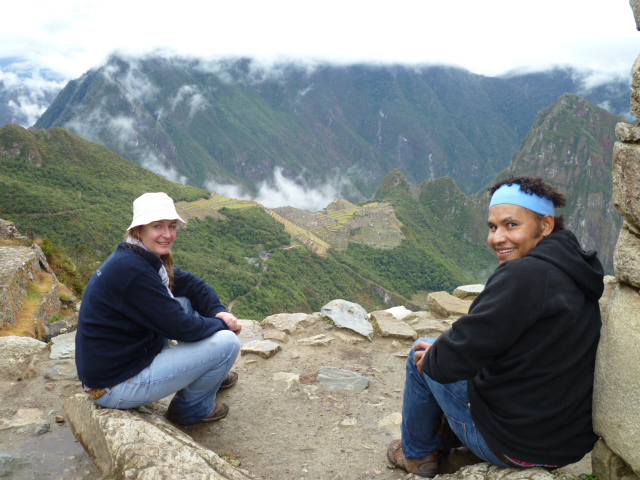
Doing the last stretch of the Inca Trail in the dark to be at the Sun Gate for sunrise is memorable if nothing else! As the ancient city is in the cloud forest it is sometimes difficult to see the sunrise through the clouds. You still remember it though! Alternatively, do the Short Inca Trail and arrive here in the afternoon. It’s not necessarily the view from the Sungate itself that gives the best pictures. It’s the points along the trail to Machu Picchu (which you can see faintly above my hat in this picture).
Note: To do the 4 day Inca trail and arrive at dawn you need to book approximately 6 months in advance.
Feel free to read our guide on the best treks to Machu Picchufro more inspiration!
Huayna Picchu (Young Peak)
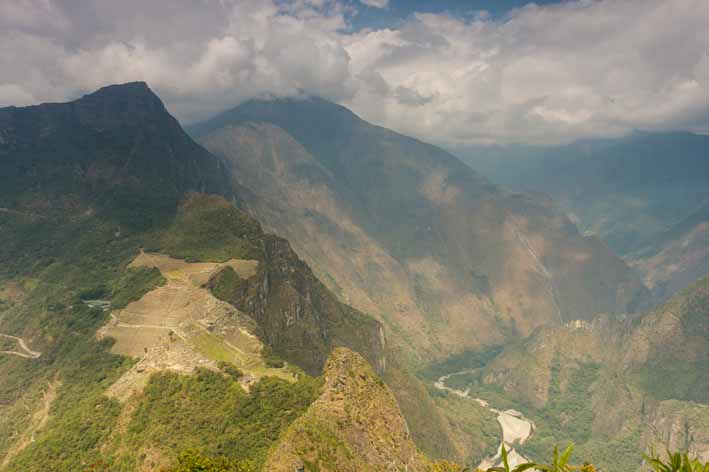
Huayna Picchu peak dominates pictures of Machu Picchu – what fewer people realise is that it also offers some great opportunities for the best photos of Machu Picchu. If you climb it, it is likely to be the highlight of your visit to the Lost City. It’s a tough couple of hours upon narrow stairs. However, you will never ever forget the impressive view of the ruins. Not recommended for people with the fear of heights or poor fitness. Totally worth the climb to get the best Machu Picchu photos though!
Huchuy Picchu (Small Peak)
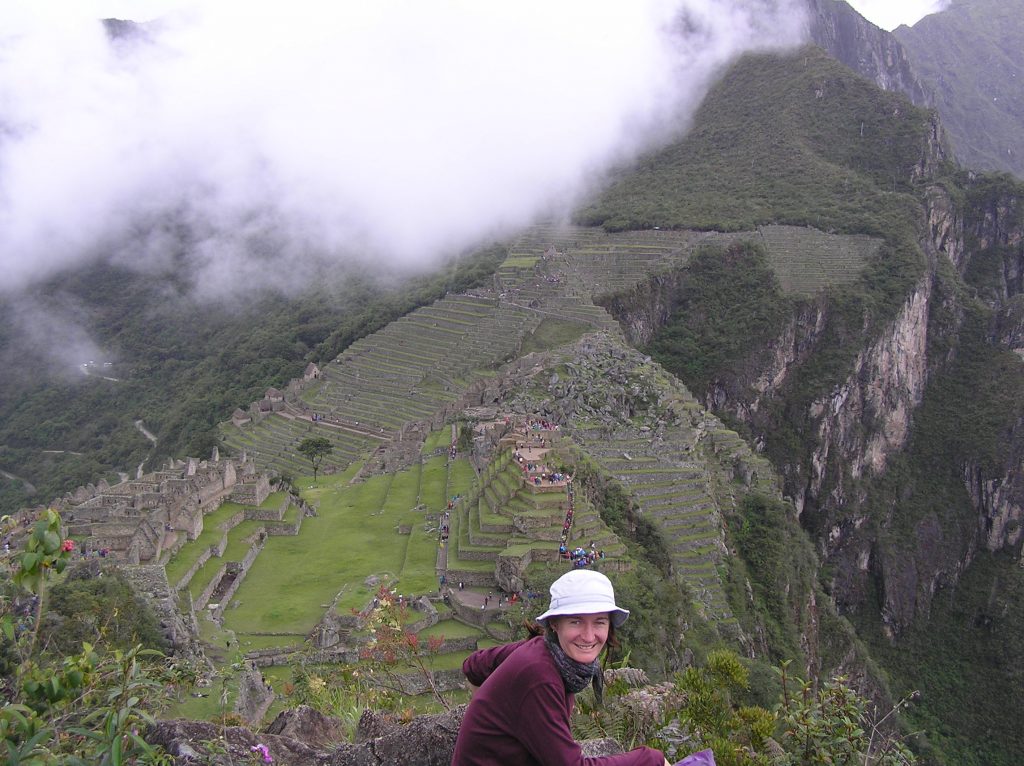
Full of gung-ho (they will need it) to get up Huayna Picchu people tend to race past the unassuming trail to Huchuy Picchu. However, it is well worth a look for its close up an overview of the ruins, and a pretty cool angle for your Machu Picchu pics. We love Huchuy Picchu as it has a lot less climbing than for the bigger peak behind it!
Montana Machu Picchu
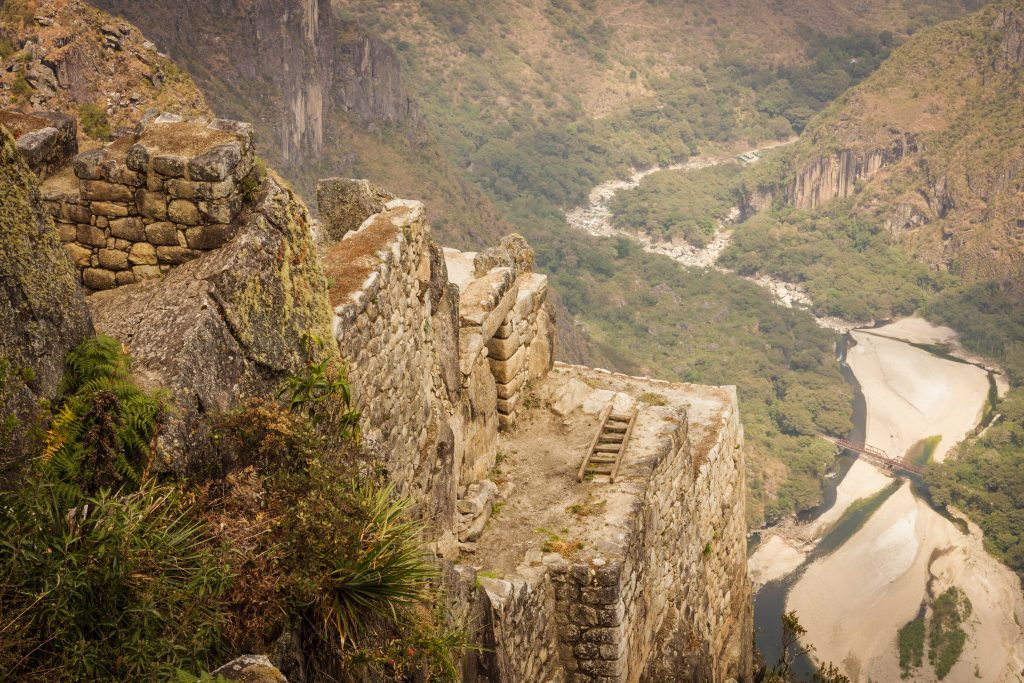
Montana Machu Picchu is the mountain peak above the ruins itself. It often has the rainbow colored flag of Tayhuantinsuyo flying. The climb of Machu Picchu Mountain takes about 3 hours return and is steeper and more difficult than Huayna Picchu. Now that Huayna Picchu books out months in advance, many people choose to do the Machu Picchu Mountain. Requires entry permits and offers awesome photos of Machu Picchu.
Hiking Up And Down To Machu Picchu

For those that like a relatively easy climb, or descent, it takes about an hour to the bridge below Machu Picchu. Not only do you feel somehow superior to those in the tourist buses, but you also get an appreciation of what an awesome feat it was to build a city high on a ridge! Look at the fantastic rainbow picture we got one day when hiking down from Machu Picchu! Always be on the lookout for the best Machu Picchu pictures, as some of the ones we have captured aren’t even of Machu Picchu itself but the incredible scenery around it.
Hiking Along The Railway Tracks From The Hydroelectric
Since Peru Rail has increased prices for the train trip from the Hydroelectric to Aguas Calientes, more people are hiking for 2 hours along the train track. The lower ruins of Machu Picchu tower above you, perched with breathtaking audacity over a gorge, and tourists seem like ants.
Llactapata (High Town)
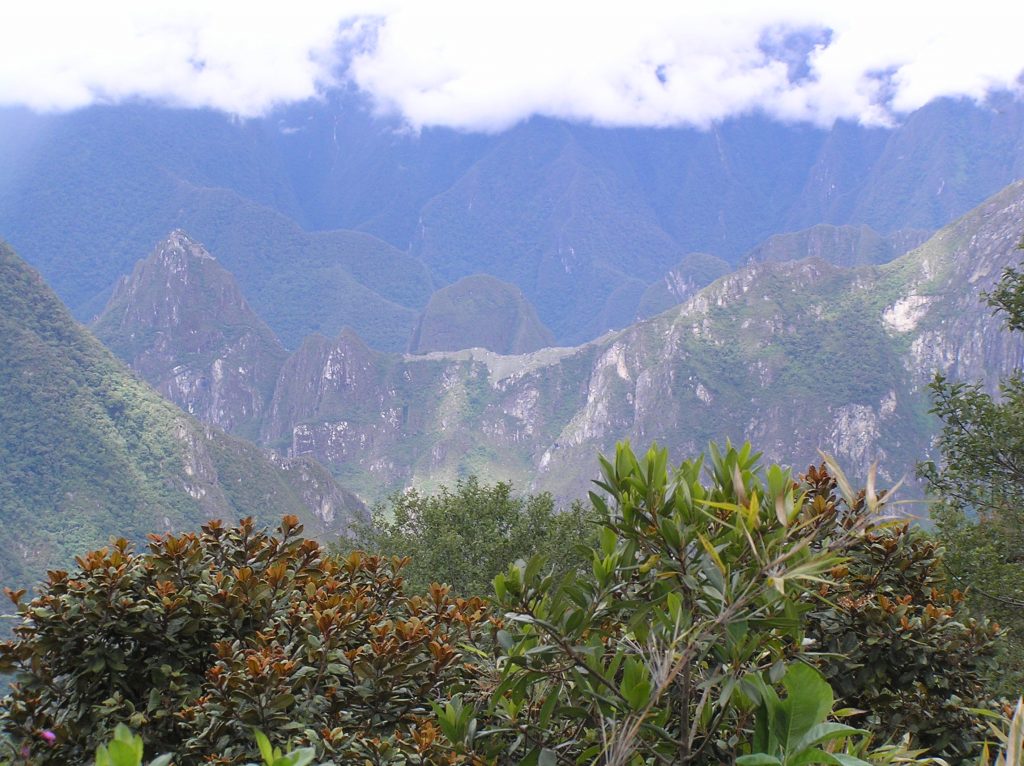
Llactapacta ruins were rediscovered in 2002 (after being lost from Europeans for nearly 100 years!) and their position on a ridgeline across a valley from Machu Picchu helps us to understand the complexity of the network of Inca cities. It’s great to camp here and see the ruins of Machu Picchu from your tent. Most people would do this as an extension or part of several of the Salkantay Treks. Apus Peru offers it as part of its’ 5 day Salkantay trek and our main advice is – make sure you have enough fuel in your tank to do this on day 4 – you won’t regret the awesome perspective of Machu Picchu.
Mandor Pampa
Mandor Pampa is a stop on the hydroelectric train ride, or a short hike from Aguas Calientes – and you can visit the botanical garden and waterfall here as a nice day trip. Far away from the crowds you get in touch with the cloud forest and get a good look at Huayna Picchu.
Putu Cusi

Not for the faint-hearted, Putu Cusi is the mountain opposite Machu Picchu. Climbing is up rickety ladders and steep slopes making this Machu Picchu photo op solely for adrenaline junkies and those that really want to get a different perspective on the famous city. Highly recommended! No entry ticket required but you do need to allow about half a day extra staying in Aguas Calientes.

Machu Picchu Regulations – Latest Information
When we first published this post, one entry ticket got you into Machu Picchu all day, and it was easy to wander about and get yourself the best Machu Picchu pictures.
Each year the Ministry of Culture, the government body which cares for Machu Picchu, changes the rules, all in the name of sustainability. These changes can occur without any prior announcement, or only with a week’s notice. That’s why if you travel with a reputable travel agent, they should have some advance notice (but not always).
In 2024, there are now 5 different circuits around the site with the maximum visit time just 2 hours. You must take a licenced guide, – and don’t forget- Reentry to the site is prohibited. That’s right, even to go to the toilet!
If you want to get iconic shots from either Huayna Picchu or Machu Picchu Mountain, there are very limited entry coupons at 7am and 10am which sell out far in advance.
While being accompanied by a guide, and following a circuit sounds like it might cramp your style, then you should be clear and concise with your guide about your aims – eg, to get the best pictures of Machu Picchu. Besides most guides, I know pride themselves on their photographic ability and will have some interesting hints of what and where to take photos.
What Does This Mean For Someone Who Wants the Best Machu Picchu Photos?
Presumably, if you are a photographer this will mean you need to buy two permits for the one day – a costly exercise. Or, as we suggest, spread your visit over 2-3 days to get the best Machu Picchu photographs that you can!
Stay tuned or visit Apus Peru Adventure Travel Specialists directly – email: [email protected] if you need more info.
Planning a trip to Machu Picchu?
Our comprehensive Guide to Travelling to Machu Picchu breaks down all the details, from transportation options to essential tips.
Traveling with your family? Check out our guide on Peru with Kids for family-friendly tips to make your trip unforgettable. Plus, if you are a book lover or want to dive into Machu Picchu’s rich history before your journey, don’t miss our list of The 25 Best Books About Machu Picchu.
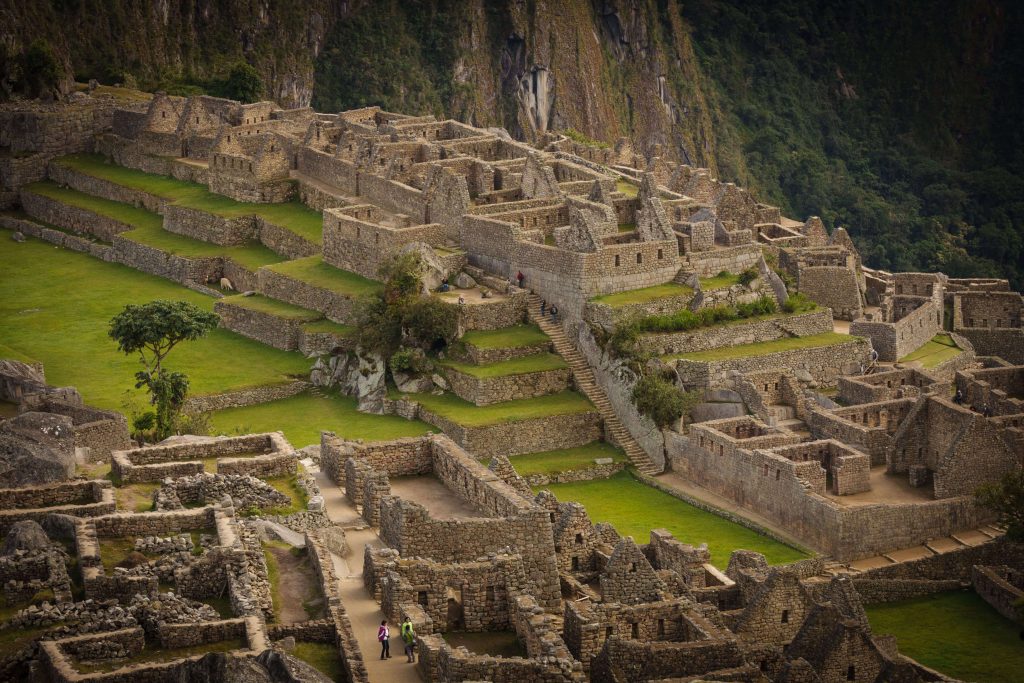
The Verdict – Getting the Best Machu Picchu Pictures
Experiencing The Lost City Of The Incas and everything Cusco has to offer is priceless. As we said, these tips for capturing the best Machu Picchu pictures have been compiled after many visits to Machu Picchu. Photos of Machu Picchu are not hard to capture, but they do require some effort and patience if you want to make them simply awesome!
Have you visited Machu Picchu? Share your pictures of Machu Picchu and any photography tips below.
Tips For The Best Machu Picchu Pictures > Pin it > Share it!














